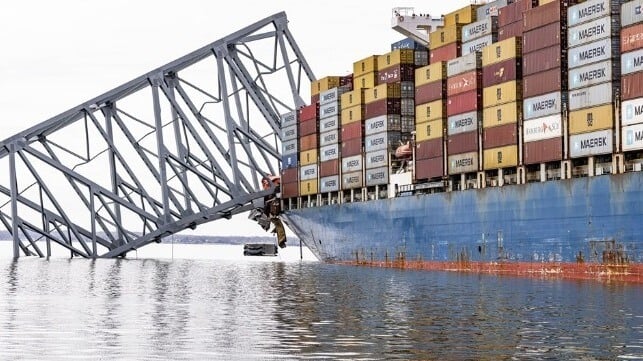Plaintiffs Claim That Boxship Dali Had "Inoperable" Port Anchor Controls

The container ship Dali had issues with its auxiliary power system in the days before its fateful voyage down the Patapsco River last year, but that wasn't all, according to new claims from plaintiffs. In a new filing, plaintiffs in the civil suit against Dali's owner and operator allege that one key piece of deck equipment may also have had known issues before the ship hit and destroyed the Francis Scott Key Bridge.
According to the attorneys, the hydraulic brake control on Dali's port anchor windlass was inoperable, and had not worked for two weeks prior to the casualty voyage. This may not have been an immediate concern under normal circumstances, since the brake could still be operated by hand.
However, the lawyers allege that the manual brake control needed two people to operate. Only one crewmember was posted on the bow of the Dali during the outbound transit, and when called upon to deploy the port anchor, "he was unable to do so," the attorneys claimed.
The anchor windlass figured prominently in the final minutes of the voyage in the early hours of March 26, 2024. After Dali lost power and drifted towards a bridge pylon, the master gave an urgent order to deploy the port anchor "fast fast" at 0127:14 - but the sound of the anchor chain was not picked up on the VDR bridge audio recording until 0129:00. The Dali hit the bridge 37 seconds after the sound of the chain beginning to run. Quicker deployment of the port anchor would have exerted steering forces to port for a longer period of time, in addition to any effects in reducing the ship's forward momentum.
In addition, the attorneys noted that Dali had two auxiliary generators up and running before the back-to-back power losses that led up to the allision. If the ship had been running three generators during the transit, "the second blackout would never have occurred," the attorneys argued, citing testimony from Dali's chief engineer.
The owner of the Dali, Grace Ocean, has filed a federal suit to limit its liability to the value of the ship post-salvage, which it estimates at $44 million. Dozens of claimants - families of the deceased, local government bodies, the federal government, cargo interests and others - oppose the motion and seek to recover far greater amounts of compensation. The cost of bridge replacement alone is expected to come to several billion dollars.
